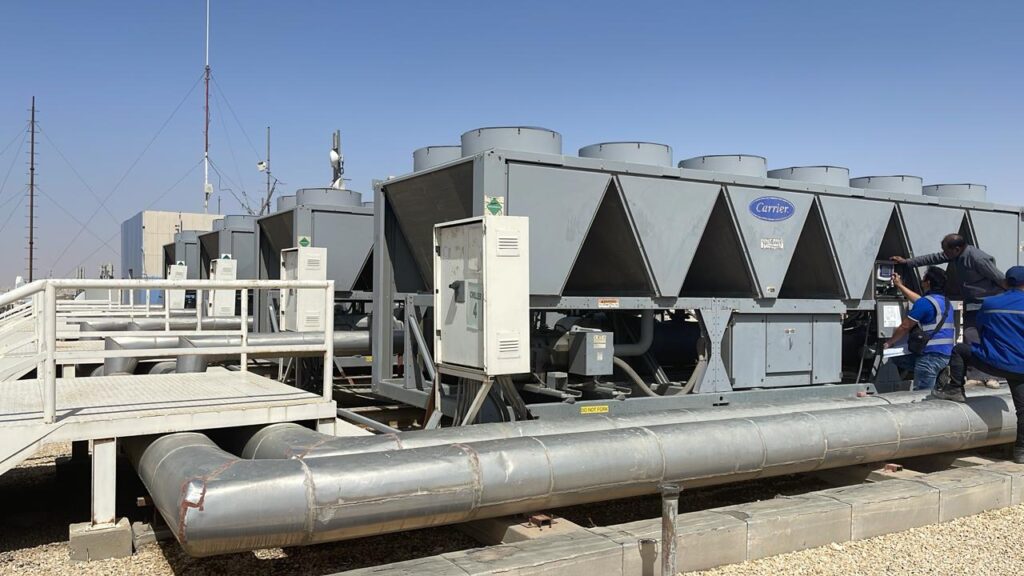
The cooling capacity is calculated for air conditioning schools and universities with the full student capacity (beginning of the school year, exam times) to overcome the large heat load, also taking into account the percentage of fresh air specified for each individual, and all of these standards are shown in the tables in the code (ASHRAE).
To deal with the redundant cooling capacity needed throughout the week, consideration is given to dividing the school or university into separate areas with air conditioning, such as feeding the reception area, corridors, classrooms, laboratories… etc., so that this distribution allows the use of a partial operation system or phased operation, which reduces the operational cost of the place and provides Electricity as well and reducing maintenance
To mention but not limited to the air conditioning and heating system, all the temperatures and humidity levels required for each room, corridor, gyms, swimming pools, dining halls, and meeting rooms also determine the percentages of fresh air for each individual.
Most hotels take advantage of all the space on the upper deck to create outdoor seating areas, open swimming pools, etc
Here comes the problem of providing space for external air conditioning units, so there are some architectural solutions, such as creating a setback that is used to place the units on the back exterior wall of the hotel in the case of hidden air conditioners.
Or allocate a closed, specific space on the roof in which all the external units can be assembled, with a dividing wall and entry door for easy maintenance.
There are some solutions by choosing the appropriate air conditioning system. Recently, the VRV or VRF air conditioning system began (which consists of a number of different types of indoor units assembled on a single copper network with one outdoor unit), which reduces the space required for the outdoor units.
Hotels are characterized by the large number of bedrooms, which requires a central control system “BMS” that allows monitoring of all systems at the same time with ease of control, detection and treatment of faults, and the VRV or VRF air conditioning system facilitates this process as it is equipped to be compatible with the central control system.
When distributing the air outlets, the locations of the beds in the bedrooms must be taken into account so that the cold air is not directed directly at them. Therefore, when designing, the hotel’s bedding plan must be requested to achieve this.
Some hotels have gyms, swimming pools, massage rooms, and steam rooms, each of which has special specifications and requirements that must be taken into account, which are indicated in the international code (ASHRAE) or the hotel’s own code.
When determining the location of the thermostat that controls the air conditioning devices, it is preferable to place it next to the light switches, and it can be calibrated to an average temperature that suits everyone. Some options that can be modified by the guest are specified with the thermostat, such as (on and off, fan speed).
In some cases, they are assembled in one place (control room) or a central control system is created for all air conditioners, which allows workers the ability to adjust, control, turn on and turn off quickly, safely and simply.
It is preferable to install air curtains at entrances and exits to limit the entry of hot air into the hotel, which can negatively affect cooling efficiency
Some air freshening devices can be installed in air conditioning units for corridors, restaurants, and lounges, and an operational system is created at a time to ensure that a good smell is maintained for the place on a regular and automatic basis.
Air conditioners must be periodically maintained and their filters cleaned to reduce bacteria and unpleasant odors accumulating on them and to maintain cooling efficiency.
Ventilation
According to what was mentioned in the international code (ASHRAE) regarding ventilation standards for hotels
The air renewal process comes at the top of these standards, as the air must be changed a number of times per hour, up to (6:10) times (air change rate (ACH)) in bathrooms.
This comes within the framework of protecting individuals from infection and reducing bacteria, as well as to maintain a good smell in the place.
This is done in several ways, including natural methods (ventilation holes in the walls, windows, etc.) or mechanical methods (fans that push and extract air).





